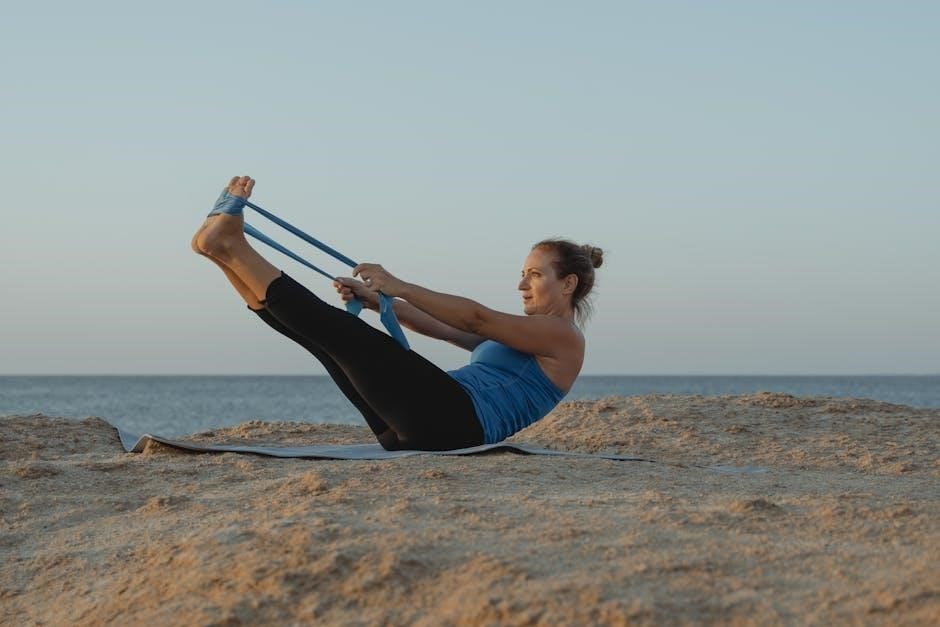IT Band Exercises PDF: A Comprehensive Guide
Welcome! This comprehensive guide provides valuable information and exercises to help manage and alleviate IT Band Syndrome. Learn about effective stretches, strengthening exercises, and rehabilitation programs. Access a downloadable PDF for a structured exercise plan.
Iliotibial (IT) band syndrome is a common ailment, especially among athletes and active individuals. It manifests as pain on the outer side of the knee, often exacerbated by repetitive movements like running or cycling. This condition arises from the inflammation or irritation of the IT band, a thick fibrous tissue that runs along the outside of the thigh, from the hip to the shin.
Understanding IT band syndrome is crucial for effective management and prevention. The IT band plays a vital role in stabilizing the knee during activity. When it becomes tight or inflamed, it can rub against the bony prominence of the knee, leading to pain and discomfort. Recognizing the symptoms early and implementing appropriate exercises and stretches can significantly improve outcomes.
This guide provides a comprehensive overview of IT band syndrome, including its causes, symptoms, and, most importantly, a range of exercises to alleviate pain and restore function. We will explore various stretches, strengthening exercises, and a sample rehabilitation program to help you regain pain-free movement and return to your desired activity level.
Understanding the IT Band
The iliotibial band, commonly known as the IT band, is a thick band of fibrous tissue that extends along the outside of the thigh. Originating at the hip, it runs down the leg, attaching to the outside of the shinbone just below the knee. Its primary function is to provide stability to the hip and knee joints during movement, particularly during activities like running, walking, and jumping.
Understanding the IT band’s anatomy and biomechanics is essential for grasping the causes and treatments of IT band syndrome. The IT band acts as a dynamic stabilizer, assisting in both hip abduction and external rotation. It also plays a crucial role in controlling knee movement and preventing excessive inward rotation of the leg.
Unlike a muscle, the IT band is a non-contractile tissue, meaning it cannot actively shorten or lengthen. However, it can become tight or inflamed due to various factors, leading to pain and discomfort. Recognizing the IT band’s role in lower limb mechanics is the first step towards effectively addressing IT band-related issues.
Common Causes of IT Band Syndrome
IT Band Syndrome, a frequent ailment among athletes and active individuals, arises from a combination of factors that contribute to the irritation and inflammation of the IT band; One common cause is repetitive movements, particularly those involving knee flexion and extension, such as running or cycling. These activities can lead to friction between the IT band and the lateral femoral epicondyle (the bony prominence on the outside of the knee).
Biomechanical imbalances, such as excessive pronation of the foot, leg length discrepancies, or weak hip abductor muscles, can also contribute to IT Band Syndrome. These imbalances alter the alignment of the lower limb, placing undue stress on the IT band.
Inadequate stretching and warm-up routines, combined with overuse and sudden increases in training intensity, can further exacerbate the condition. Tightness in the hip flexors, quadriceps, or hamstrings can also increase tension on the IT band, predisposing individuals to IT Band Syndrome.

IT Band Stretches
Targeting the IT band with specific stretches can help alleviate tightness and reduce pain. Several effective stretches can be performed to improve flexibility and promote healing. Explore these techniques for relief.
Standing IT Band Stretch
The standing IT band stretch is a simple yet effective way to target tightness in the iliotibial band. Begin by standing with your legs crossed, placing the uninjured leg in front of the injured leg. Reach toward your toes, allowing your body to bend sideways toward the uninjured side.
Focus on feeling a stretch along the outside of your thigh on the injured side. To deepen the stretch, you can extend your arms overhead and reach towards the uninjured side. Hold the stretch for 30 seconds and repeat three times on each side.
Remember to keep your movements slow and controlled, avoiding any sudden jerks. This stretch can be performed anywhere, making it a convenient option for managing IT band discomfort throughout the day. Listen to your body and stop if you experience any pain.
Side-Leaning IT Band Stretch
The side-leaning IT band stretch is another excellent option for targeting tightness. Stand sideways near a wall, positioning your injured leg closest to the wall. Place the hand nearest the wall on the wall for support, ensuring a stable base. Cross your outside leg in front of the leg closest to the wall.
Gently lean your hip towards the wall, allowing your body to create a gentle arc. You should feel a stretch along the outside of your thigh on the leg furthest from the wall. Maintain a straight line from your head to your crossed foot.
Hold this position for approximately 30 seconds, and repeat the stretch three times on each side. Remember to breathe deeply and evenly throughout the stretch, focusing on relaxing the muscles in your outer thigh. If you experience any sharp or intense pain, discontinue the stretch immediately and consult with a healthcare professional.
Foam Rolling Exercises for IT Band
Foam rolling is a self-myofascial release technique that can help to alleviate tightness and improve flexibility in the IT band. To perform this exercise, lie on your side with the foam roller positioned under your affected thigh, just below your hip.
Use your arms to support your upper body and your other leg to provide stability. Slowly roll your body along the foam roller, moving from your hip down towards your knee. If you encounter a particularly tender spot, pause for a few seconds and allow the pressure to release the tension in the area.
Continue rolling for approximately 30-60 seconds, and repeat on the other leg. It is important to note that foam rolling can be uncomfortable, but it should not be intensely painful. Adjust the pressure as needed and discontinue if you experience any sharp or shooting pain. Remember to breathe deeply throughout the exercise.

IT Band Strengthening Exercises

Strengthening exercises are crucial for IT band syndrome rehabilitation. These exercises target the muscles that support the hip and leg, helping to improve stability and reduce strain on the IT band.
Hip Abduction Exercises
Hip abduction exercises are essential for strengthening the gluteus medius, a key muscle in stabilizing the pelvis and controlling leg movement. A weak gluteus medius can contribute to IT band issues. These exercises help to prevent the knee from collapsing inward during activities, reducing strain on the IT band.
Performing hip abduction exercises regularly can improve lower body mechanics and alleviate pain associated with IT band syndrome. Examples include side-lying leg lifts, standing hip abductions with resistance bands, and using an abduction machine at the gym.
Start with a low resistance or no resistance and gradually increase as your strength improves. Focus on maintaining proper form to maximize effectiveness and prevent injury. Remember to consult a physical therapist or healthcare professional for personalized guidance and to ensure these exercises are appropriate for your specific condition. Consistent training will promote better hip stability and support IT band health.
Glute Bridge Exercises
Glute bridge exercises are highly effective for strengthening the gluteus maximus, a major muscle in the posterior chain. Strengthening the glutes is crucial for IT band health because strong glutes help control hip and leg movements, reducing stress on the IT band. Glute bridges also engage the hamstrings and core, contributing to overall stability.
To perform a glute bridge, lie on your back with knees bent and feet flat on the floor. Lift your hips off the ground, squeezing your glutes at the top of the movement. Hold for a few seconds and then slowly lower back down.
Variations include single-leg glute bridges, which increase the intensity and challenge balance, and resisted glute bridges using a resistance band around the thighs. Aim for controlled movements and proper form to maximize benefits. Regular glute bridge exercises can improve hip extension strength, reduce IT band strain, and enhance lower body function, aiding in the prevention and management of IT band syndrome.
Single Leg Deadlifts
Single-leg deadlifts are a fantastic exercise for improving balance, stability, and strength, all of which are vital for IT band health. This exercise targets the glutes, hamstrings, and core muscles, helping to correct imbalances that can contribute to IT band issues. By strengthening these muscles, single-leg deadlifts promote proper alignment and reduce strain on the IT band.
To perform a single-leg deadlift, stand on one leg with a slight bend in the knee. Hinge at the hips, extending the opposite leg straight back while keeping your back straight. Lower your torso until it’s parallel to the ground, or as far as your flexibility allows, and then return to the starting position.
Focus on maintaining balance and control throughout the movement. You can hold a light weight in your hands for added resistance. Incorporating single-leg deadlifts into your routine will enhance hip stability and functional strength, which is important for preventing and managing IT band syndrome.

Rehabilitation Program for IT Band Syndrome
This section details a structured rehabilitation program designed to alleviate IT Band Syndrome. It includes exercises for recovery, progression guidelines, precautions, and advice on when to seek professional help.
Sample Exercise Program (PDF Download)
This section provides a sample exercise program tailored for IT Band Syndrome rehabilitation. The program includes a combination of stretches and strengthening exercises designed to address common causes and symptoms. You can download the complete program as a PDF for easy access and printing.
The PDF includes detailed instructions and illustrations for each exercise, ensuring proper form and technique. This program aims to improve flexibility, strengthen supporting muscles, and reduce pain associated with IT Band Syndrome. Remember to consult with a healthcare professional before starting any new exercise program, especially if you have underlying health conditions.
The downloadable PDF offers a structured approach to rehabilitation, allowing you to track your progress and adjust the program as needed. It’s a valuable resource for individuals seeking a comprehensive and effective way to manage their IT Band Syndrome symptoms.
Progression and Precautions
When starting an IT Band exercise program, gradual progression is crucial to avoid further injury. Begin with a low-intensity level and gradually increase the duration and intensity of exercises as your pain decreases and strength improves. Pay close attention to your body’s signals.
It’s essential to listen to your body and stop immediately if you experience sharp or increasing pain. Proper form is critical to prevent injury. If you are unsure of the correct technique, consult a physical therapist or healthcare professional. Avoid overstretching or pushing yourself too hard, especially in the initial stages.
Individuals with pre-existing conditions should seek medical advice before starting any new exercise routine. Remember to warm up before each exercise session and cool down afterward. Hydration is also important for muscle health and recovery. Taking these precautions will help you safely and effectively manage your IT Band Syndrome.
When to Seek Professional Help
While self-managed exercises and stretches can be beneficial for IT Band Syndrome, there are situations when seeking professional help is essential. If your pain is severe, persistent, or worsening despite consistent home treatment, consult a healthcare professional. This includes persistent pain that interferes with daily activities or sleep.
Seek immediate medical attention if you experience any signs of nerve involvement, such as numbness, tingling, or weakness in your leg or foot. A healthcare professional can accurately diagnose the cause of your pain and rule out other potential conditions. They can also provide a personalized treatment plan tailored to your specific needs.
If you are unsure about the correct way to perform exercises or stretches, or if you have any underlying medical conditions, it’s best to seek guidance from a physical therapist or sports medicine specialist. They can provide expert advice and ensure you are performing exercises safely and effectively. Don’t hesitate to seek professional help if you have any concerns about your IT Band Syndrome.
